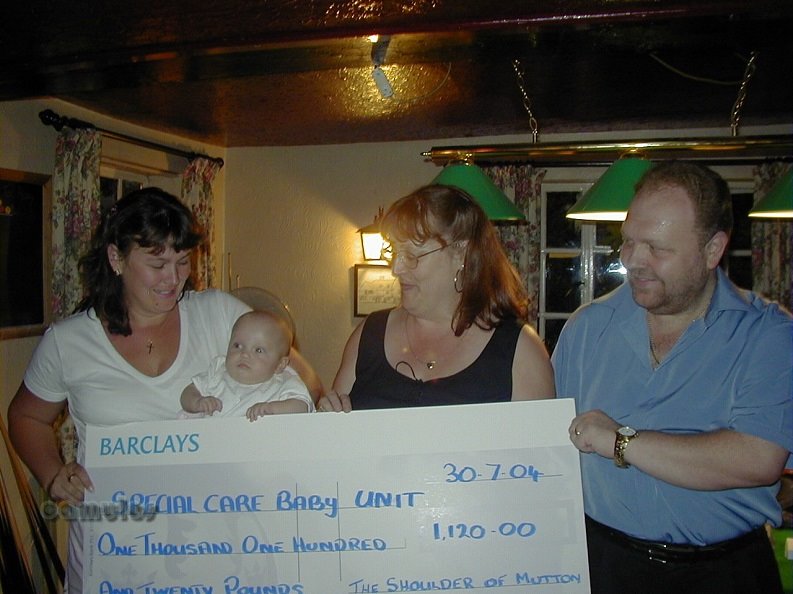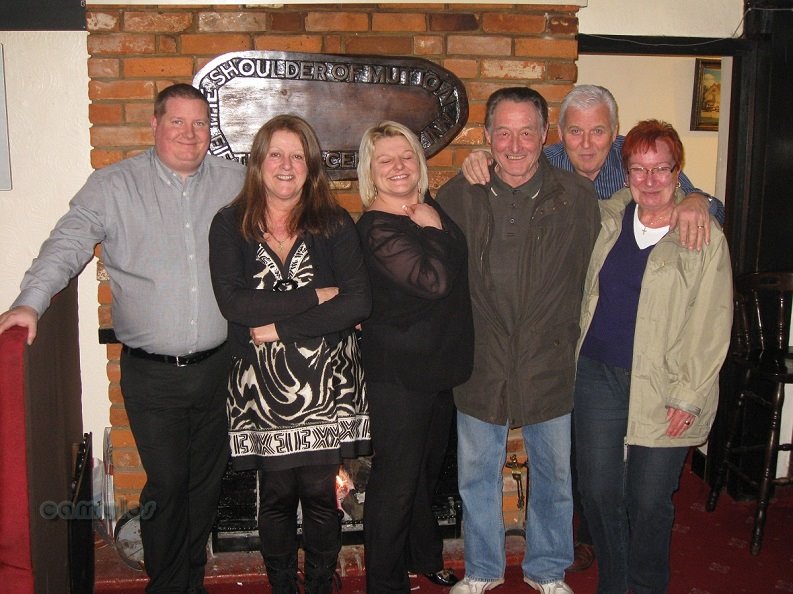SOME HISTORY!
The medieval
timber framed building known as the Shoulder of
Mutton appears to have been originally built as a
private house, perhaps for a copyhold tenant, maybe
a yeoman farming family, around the year 1380. It
was constructed in a typical style of that period
(a Wealden style house) in oak having two cross
wings and a hall. The angle of slope of the roof
suggests that it has always had a clay tile roof
(not thatch or shingles), a roof style which came
into use from around 1200.

c 1910. Nicholl
and Co.

With Mr Clampin
standing 3rd from left with bowler
hat.
Referring
to the typical plan layout shown below (this is not
necessarily exactly as the Shoulder was), the
original design (pre 1600) would have comprised a
central hall, fully open to the roof, with a hearth
in the centre for warmth. It is unlikely that
cooking was done here due to the risk of setting
fire to the building, this probably being done in a
separate building close by, now gone. The smoke
from the hearth would percolate up into the roof
space and find its way out through windows and gaps
in the tiles.
Some time in the
17th century, this central hall was completely
removed and replaced with the present section so
that additional accommodation from an upper floor
and a brick chimney could be introduced, as
happened to so many other buildings of this type at
that time. Folk didn't want a draughty old hall
reaking of smoke. The new fashion was to install a
chimney where the smoke problem could be eliminated
- a new era of comfort in the home.

To the right of
the plan is a cross wing, with upper storey, split
in two at ground level, for use as service areas,
perhaps a buttery and a pantry with store rooms or
sleeping quarters for servants above. This was the
low status end of the house, for employees and
servants. The position where the two doors leading
into the service rooms were situated can clearly be
seen in what is now the restaurant area. The
partition wall and the doors have been removed at
some point and the wall that separated the hall
from the service rooms has been stripped of its
wattle and daub infill to make the room more open
plan. The existing fireplace in the corner of the
room is a recent addition. At the opposite side in
what was the other service room is clear evidence
of a diamond barred window and a trimmer in the
ceiling where a stairway would have led up to
storage rooms in the floor above. Remember that
windows did not use glass until around 1550, so the
vertical diamond shaped bars acted as a deterrent
to intruders (the diamond shaped holes are still
there where the bars once fitted). Also still there
are the top and bottom slots where a simple shutter
was able to slide over the window. There is also
evidence in the side wall of a further window, now
only visible from outside the building, due to
internal plastering and panelling. The mortice
slots of the dividing wall cannot be seen as
panelling has been used to cover up the overhead
beam. The front wall of the building in the
restaurant area has been considerably altered in
recent times, perhaps the mid 19th century, to
provide the window and wall area.
From the
outside, the jettied (jutting-out) upper floor is
visible. Jettying was a fashionable feature of the
time, usually only appearing on the public side of
the building so that passers-by could judge the
importance of the owner. Jettying also gave
additional floor space above. There is evidence of
the brackets that gave additional support to the
jettied structure. This jettying is repeated along
the whole front of the building, although
considerable changes have been made to the frontage
over the centuries.
The roof of the
cross wing uses the tried and tested crown post
system where a continuous beam helps to keep the
roof trusses upright with additional braces and end
support from hipped gables.
There is a
section of a jettied extension attached to the
service cross wing, which would probably have been
much bigger at one time. There is evidence of a
small window between it and one of the service
rooms. It had a side purlinned roof.
The difference
in size of the oak timbers is evident between the
17th century central section and the 14th century
cross wing. The earlier building , as was normal at
that time, was greatly over-engineered by today's
standards. The vertical posts were based on whole
tree trunks, squared off in their 'green' state by
the carpenter before cutting and marking the joints
prior to assembly. It is extremely difficult to cut
seasoned oak so it is probable that the timber used
was all fresh cut at the time of the building's
construction, making dendrochronology (tree-ring
dating) a very useful method of accurately dating a
building. By contrast, the later building section
has much smaller timber sizes.
The gaps between
the building's timber framework were infilled with
wattle and daub. This comprised thin sticks (often
coppiced wood) sprung into place vertically between
the upper and lower bearers. Then smaller sticks
were used, intertwined horizontally between the
vertical poles and fixed with bast (a form of
binding from the lime tree), to form a grid onto
which could be put a mixture of mud and straw. This
was set back slightly to allow a final coat of hair
(probably horse hair) plaster to give a smooth
finish. As time went on, especially on outside
wall, gaps opened up and draughts became a
nuisance, so the outside walls were fully
plastered, covering up the timber frame, as is
evidenced by old Victorian photographs. Then of
course, in the 20th century it became fashionable
to uncover all the beams again, as can be seen with
so many old buildings of this type
today.
Returning to the
14th century central hall that once existed, this
would have had a high end and a low end. This was a
social status issue where the family would have sat
at on a bench in front of a trestle table at the
high end, warming themselves and in full view of
the cross passage, whilst the workers would use the
low end. Two doors would have existed to form a
cross passage through the building from front to
back, sometimes screened but usually just a simple
thoroughfare. Privacy for the family must have been
minimal in the hall area, especially when you
consider that the hall would also have been the
area where the family slept.
At the high end
was a further cross wing, known as the parlour
(from the French word 'parler' to speak). This wing
was of a superior construction than the cross wing
at the low end and does not appear (due to the
absence of mortice slots) to have had a dividing
wall. There is an interesting knee feature giving
additional support, which was probably matched at
one time with another knee opposite, before later
building modifications were made (the modern day
entrance has been much modified in recent times).
Evidence of the original double window on the front
face is clear from the diamond slots and the
shutter grooves on each side. The parlour cross
wing area was the private domain of the family with
no access to it from the opposite wing at the low
end of the building. It has been considerably
modified over the years to add an extension where
the pool table is now situated, and a further rear
extension for the toilets is comparatively
modern.
At some stage,
the building became an inn. It is known that the
parlour part of the building was used as a
butcher's shop, which is shown in an old
photograph. This is probably why the name, the
Shoulder of Mutton, was taken up. As with the Three
Horse Shoes and the Vulcan, both Fordham pubs, and
both associated with the trade of the blacksmith or
farrier, inns and taverns often took a name that
was associated with a nearby or in-house trade. The
original owner of the building was probably a
yeoman farmer who owned land in the area and
provided work for others in Fordham. The house was
built next to the river and close to the ford that
would have existed on the Colchester to Halstead
road. It would be interesting to search through
Fordham Wills and Inventories of past residents to
see whether a family can be identified who might
have lived there at some
time.
![]()








